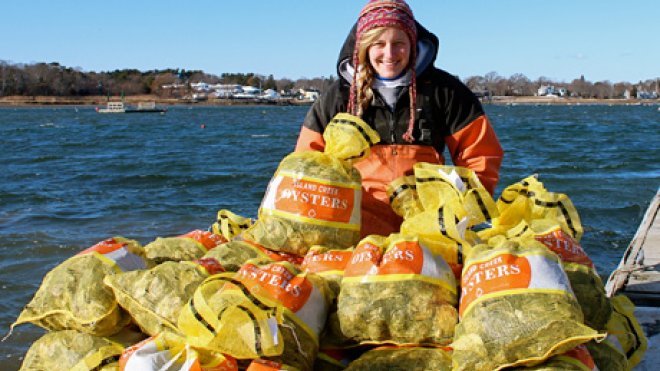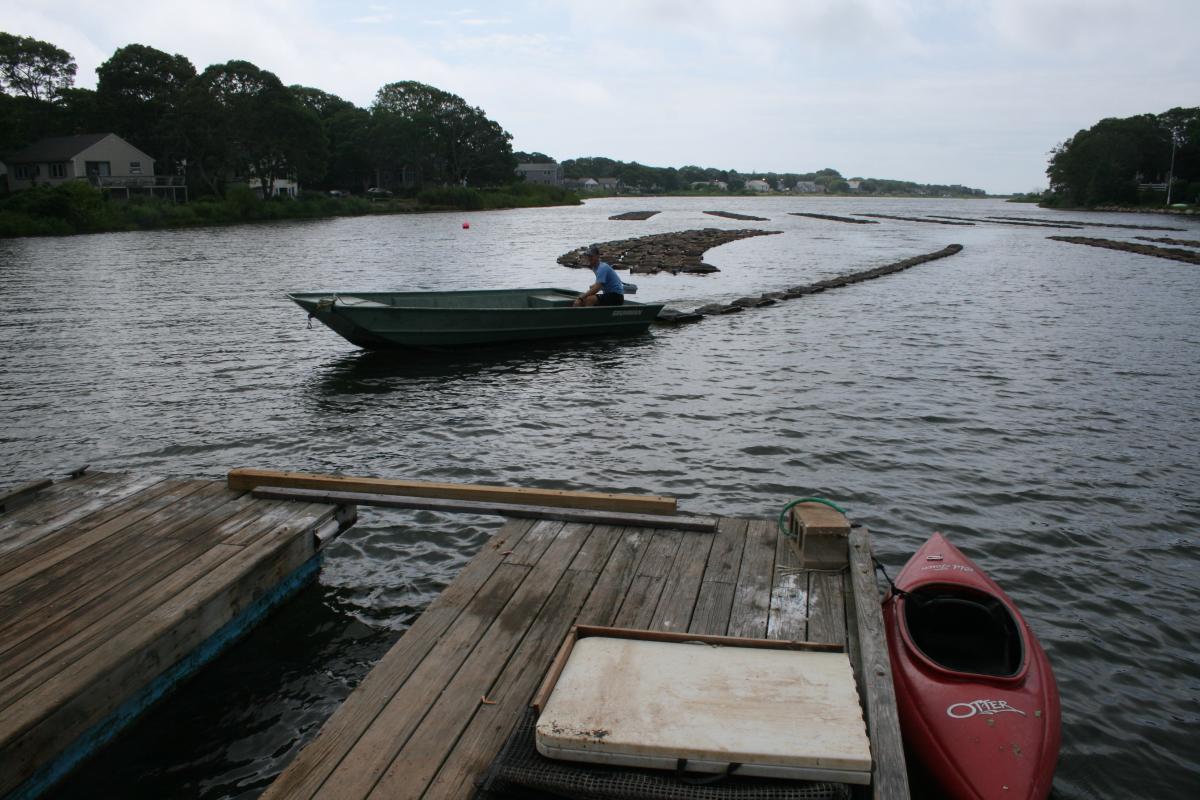Oysters, Oysters Everywhere
OGRE alumni in the field extol the ecological benefits of oyster farming

BRISTOL, R.I. – It’s been just two years since Hannah Pearson ’13 left the Luther Blount Shellfish Hatchery at RWU, but she has waded into familiar territory just an hour north at the Island Creek Oyster Farm in Duxbury, Mass.
As shellfish hatchery manager, Pearson spends her days in “The Treehouse” – a multi-level aquaculture lab created in a warehouse adjacent to the Duxbury Harbor. (Think your cubicle, but way cooler.) It’s here that Pearson raises her “babies”: 100 million oyster eggs — 12 miilion of which became mature enough this season to go from farm to fork via Island Creek’s wholesale market.
But Pearson’s is not your typical Monday through Friday, 9 to 5 job. For 10 months of the year, she is at the beck and call of the baby oysters, cleaning and feeding them.
“A lot of it has to do with timing,” Pearson says. “If you don’t use the algae in the right amount of time, it will start to die. I can’t keep the oysters in a 5-gallon tank for too long because it’s too crowded for them to survive. From January to July, I’m working every single day. Animals need to be taken care of every day – they don’t take Saturdays and Sundays off. But I’m used to it, and I love it.”
Because all of the water used in the hatchery’s 2,500-gallon tank is drawn from the bay, Pearson is reliant on the tide charts – meaning that if high tide is at 1:00 a.m., Pearson will be at the hatchery to fill the tank.
“At times I have 100 million babies I’m taking care of,” she says. “It’s challenging, but at the same time those babies need to be fed and it’s rewarding to see them growing and succeeding.”
Also rewarding? The environmental benefits of oyster farming, Pearson says.
“The whole process of growing an oyster from day one when they’re eggs is environmentally friendly,” she says. “There is no waste in the production. We produce no emissions, and in my hatchery I only use a small amount of electricity. It’s a very sustainable process, because we let the ocean do the work for us – that’s the way you’re going to get a good looking oyster, and there’s no harm to anyone.”
Like Pearson, Ryan Rezendes ’14 is also operating a commercial oyster farm – but while Pearson is raising her oysters for human consumption, Rezendes is raising his 2 million oysters to filter the water. The two worked together on the RWU Oyster Gardening Restoration and Enhancement (OGRE) program (each earning President's Core Values Medallions at their respective graduations) and Rezendes now spends his days in Falmouth, Mass., where he is the shellfish manager and biologist at Little Pond. The pond, which was once swimmable, has been plagued with water quality issues for years.
Rezendes is leading a pilot study with the Department of Marine and Environment to evaluate how well the oysters can clean the water. Just halfway into the three-year study, Rezendes reports that water clarity is markedly improved and neighbors say they can now see the bottom of the pond.

“The neighbors love the project, for the most part,” Rezendes notes. “That came as a bit of a surprise. A lot of places in Rhode Island oppose oyster farmers in their backyards. These folks see it as a win-win, and understand that it will help clean up their water.”
Both Pearson and Rezendes credit Associate Professor Dale Leavitt and their training at the RWU hatchery for helping them land jobs almost immediately upon graduation – and for providing them with a solid scientific foundation to apply to oyster aquaculture in the field.
“It’s been great working with the farmers here, explaining to them the process,” Pearson says. “There are no other scientists here. They have hatchery experience, but never knew the science behind it. I have my knowledge from Roger Williams, they have their knowledge from messing around with hatchery work for years – together it’s a lot of collaborating, putting ideas together and making things happen.”
For his part, Rezendes enjoys being out in his “office” – a raft he built in the middle of Little Pond – and splits his time between the pond and the lab, where he’s documenting all of the data he tracks on his oysters. He frequently brings some of Leavitt’s students out to the pond to work alongside him, and enjoys teaching anyone who wants to learn the ins and outs of oyster aquaculture. He is currently in talks with graduate programs from Boston to Tasmania, which is the world leader in oyster farming according to Rezendes.
“Oyster aquaculture in Rhode Island has exploded over the past decade or so, up 15 percent each year. It’s really taken off,” he says. “But in Tasmania and Australia as a whole, the operations are massive and far more developed – and it’s an environmentally friendly business.”
Ultimately, Rezendes says he would like to travel to developing countries and help to implement valuable shellfish farming methods and establish aquaculture practices that could supply viable protein sources.
Pearson plans to stay on with Island Creek for the foreseeable future, both in her hatchery and out on the farm, which has given her an even deeper appreciation of her bivalve babies:
“My favorite thing about oysters is that every single one is different,” she says. “At the microscopic level in the hatchery, you don’t see that – they’re all the same size and same color. On the farm, we go through about 25,000 oysters a week that we then sell. Touching every single one, measuring them, sorting them, you get to know how different they really are.”
And, she says, they are perfectionists.
“All oysters want to grow into perfect oysters,” Pearson says. “The funny looking ones get thrown back into the water for a few months, and will correct themselves into a perfect shell – straight out from the hinge, a deep dome shape and a really nice beveled shell.”
Talented and tasty – a winning combination for ponds and plates everywhere!